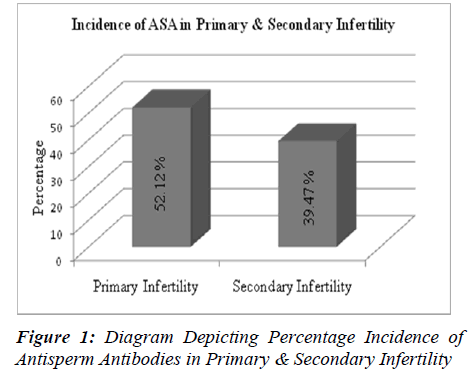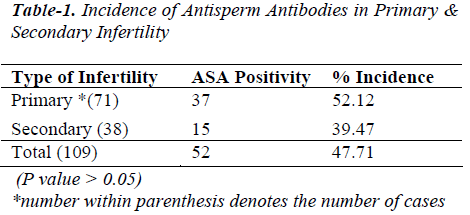ISSN: 0970-938X (Print) | 0976-1683 (Electronic)
Biomedical Research
An International Journal of Medical Sciences
- Biomedical Research (2011) Volume 22, Issue 3
Antisperm Antibodies in Primary and Secondary Infertile Couples of Central India
Department of Physiology, MGIMS, Sevagram, India
Accepted April 19 2011
Immunologic factors are considered as important cause for infertility. One of the immu-nologic factors proposed for infertility is presence of antisperm antibodies (ASA) in serum. ASA are found in cervical mucus, seminal plasma and sera of men and women. It is possible for couples with antisperm antibodies occasionally to beat the odds and become pregnant. Acquisition of genital tract infection following the initial pregnancy can lead to subsequent development of antisperm antibodies. So the aim of this study was to find out the incidence of antisperm antibodies in primary and secondary infertile couples of central India. A cross sec-tional study included 109 couples suffering from infertility referred to the Reproductive Bi-ology Unit, MGIMS, Sevagram. Presence of antisperm antibodies (IgG and IgA classes) was estimated in the serum by Varelisa Sperm Antibodies kit method. Out of 109 infertile cou-ples, antibodies were observed in 37 couples of primary infertility and 15 couples of secon-dary infertility. The percentage incidence was 52.12% and 39.47% in primary infertility and secondary infertility. It is concluded that although the difference in the incidence of ASA in primary & secondary infertility is not statistically significant, its detection can provide a clue to the aetiologic factor in such couples.
Keywords
Antisperm antibodies, primary and secondary infertility, serum
Introduction
Immunologic factors are considered as an important cause for infertility [1]. One of the immunologic factors pro-posed for infertility is presence of antisperm antibodies in serum. Antisperm antibodies are found in cervical mucus, seminal plasma and sera of men and women [2]. While millions of spermatozoa are present within seminal fluid, only tens to hundreds found at any one instance within the fallopian tube. Immunity to sperm can cause infertility; humoral antibodies directed against sperm did not neces-sarily impair fertility unless the circulating antibodies are also present within the reproductive tract and on the living sperm surface [3].
A sexually active woman may be exposed to over a tril-lion sperm in life time which can impair fertility. Under-lying causes are probably a combination of antisperm an-tibodies effects such as sperm agglutination, reduced mo-tility, and impaired cervical mucus penetration, inefficient sperm egg fusion, enhanced phagocytosis of sperm and pre or post implantation embryo loss. Antibodies to in-trinsic sperm antigen added during passage through the epididymis and on exposure to seminal plasma at ejacula-tion are associated with unexplained infertility. Even though antibodies to sperm do not usually develop after intercourse, the female immune system may regularly respond to antigens present in the ejaculate. Epididymal sperm are more antigenic than ejaculated sperm. Seminal plasma enzymes affect sperm surface antigen expression, and seminal plasma immunosuppressive factors can abro-gate antisperm immune responses in vivo [4].
The female reproductive tract is unique in that it needs to protect itself against invading pathogenic organisms while not mounting a significant destructive immune response against allogenic sperm cells and the developing concep-tus. The female reproductive tract is not an immunoprivi-leged site but that the immune system functions locally a protective role against infectious agents and in the estab-lishment and maintenance of pregnancy but adversely on fertility by the generation of antisperm antibodies [5]. It is possible for couples with antisperm antibodies occasion-ally to overcome the situation and become pregnant. Ac-quisition of genital tract infection following the initial pregnancy can lead to subsequent development of antis-perm antibodies [6] so the aim of this study was to find out the incidence of antisperm antibodies in primary and secondary infertile couples of Indian origin.
Material and Methods
The cross sectional study, included 109 couples suffering from infertility (either primary or secondary) for more than one year duration. They were referred to the Repro-ductive Biology Unit, MGIMS, Sevagram from the de-partment of Obstetrics & Gynecology. Detailed history of present and past illnesses as well as medical and surgical treatment was taken. Selected subjects underwent thor-ough surgical examination of genitourinary system to rule out the exclusion criteria. The tests was done with due permission of the ethic committee of the Institute and with written consent from the subjects. 5 ml blood was collected from infertile couples and the presence of sperm Antibodies (IgG and IgA classes) were estimated in the serum by Varelisa Sperm Antibodies kit method (OSB India Agencies Pvt Ltd, New Delhi India).
Exclusion criteria
Subjects with Vericocoele, hydrocoele, undescended tes-tis, any structural abnormality, any history of surgical intervention in the genitourinary tract, acute febrile illness or treatment history with drugs were excluded. Female with tubal block and genital tract infection were also ex-cluded from the study.
Statistical Calculation
The incidence of antisperm antibodies between couples of primary and secondary infertility was compared to deter-mine the significance of difference by chi-square test (P value < 0.05 was considered statistically significant) us-ing SPSS (version 16.0) statistical software.
Results
Total 109 infertile couples were studied for presence of antisperm antibodies. Out of which 71 were suffering from primary infertility & 38 were of secondary infertil-ity. Amongst the 71 primary infertility couples 52.12% were positive for ASA (37 out of 71) and in secondary infertility couples the incidence of ASA was 39.47% (15 out of 38) this was statistically not significant.
Discussion
Sperm with bound immunoglobulins induce interferon Y production from allogenic lymphocytes. Thus, if the male partner has auto-antibodies on his sperm, interferon Y would be induced in the female partner after coitus. This would stimulate the expression of Ia antigens on the women’s macrophage thereby allowing T helper cells to recognize sperm components on the macrophage surface and leads to sensitization of B lymphocytes to sperm anti-gens. Increased phagocytosis of sperm by macrophage of the female reproductive tract is one of the mechanisms for infertility, as it impairs interaction with zona pellucida when antibodies occupy sperm receptor sites blocking sperm binding.
The degradation of sperm in the seminal fluid of autoim-mune husband due to cytotoxic sperm antibodies may result in increased antigenicity of the semen. Alterna-tively, the sperm may be defective per se and therefore be antigenically distinct, bearing antibody products. This could also increase the “antigenic load” of the semen. On the other hand, the macrophages present in the semen, with their ingested and opsonized sperm, may activate the antigen reactive T lymphocytes in circulation resulting in increased antibody production [7].
Antisperm antibodies can affect adversely human fertility but normally may be controlled by anti-idiotypic antibod-ies which along with immunosuppressor factors in semen prevent their induction to a significant degree. This bal-ance between detrimental and “beneficial” immune re-sponse to sperm may be shifted towards an antisperm an-tibody response by stimulatory factors such as infection [5].
Our study showed no significant difference in the inci-dence of circulating antisperm antibodies among primary and secondary infertility (Table 1), this contradict the study of Damianova V et al 1999 [8], who found the highest incidence of sperm antibodies amongst patients with primary unexplained infertility in subjects attending a programme for assisted reproduction by various test (ELISA, TAT, SIT, and GAT).
According to W B Schwimmer et al 1967 [9], the inci-dence of antisperm antibodies was 37.5% of wives & 7.8% of husband among primary unexplained infertility and 50% of women and only 1 husband had antisperm antibodies among 32 couples with secondary unexplained infertility. We found 40.84% of wives and 30.98% of husband among primary infertility and 18.42% of women & 28.94% of men were positive for antisperm antibodies among secondary infertility (Table 2). Our study also re-veals no significant difference in the presence of antis-perm antibodies between the husband and their spouses of primary as well as secondary infertility, this finding differ the study of Subbi Mathur et al 1981 [10], who found the incidence of sperm immunity was significantly higher in males than females with primary infertility.
Michael S Cookson et al 1995 [11], performed retrospec-tive study to evaluate the ability to predict sperm surface antisperm antibodies in patients with primary infertility on the basis of impaired sperm motility. He reviewed seminal characteristics of 70 consecutive ASA positive infertility patients & found patients with lower motilities were significantly ASA positive (P=0.016) as compared to patients with sperm concentrations of >20 million/ml (P=0.002) therefore, the impaired motility was signifi-cantly associated in ASA positive patients. So it is concluded that although the difference in the inci-dence of ASA in primary & secondary infertility is not statistically significant, its detection can provide a clue to the aetiologic factor in such couples.
Acknowledgement
We are grateful to the President Dhiru S Mehta and Sec-retary Dr. P. Narang of Kasturba Health Society and Dean of MGIMS, Dr. B S. Garg for all round logistic and fi-nancial support for the study.
References
- Lu J, Huang Y, Lu N. Anti sperm immunity and infertil- ity. Expert Rev Clin Immunol 2008; 4 (1): 113-126.
- Karimi F, Khazaei S, Alaedini F. Serum antisperm anti- bodies in fertile and infertile individuals. Iran J Med Sci2008; 33 (2): 88-92.
- Bronson R, Cooper G, Rosenfeld D. Sperm antibodies: Their role in infertility. Fertility and Sterility 1984; 42 (2): 171-183.
- Alexander NJ, Anderson DJ, Immunology of semen.Fertility & Sterility 1987; 47 (2): 192-205.
- Naz RK, Menge AC, Anti sperm antibodies: origin, regulation and sperm reactivity in human infertility. Fer- tility and Sterility 1994; 61 (6): 1001-1013.
- Rosenwaks C G. Reproductive Medicine Secrets. Antis- perm antibodies in infertility. 1st edition 2006; 41-48.
- Cropp CS and Schlaff WD. Antisperm Antibodies. ArchImmunol Ther Exp (Warsz) 1990;38 (1-2): 31-46.
- Damianova V, Dimitrova-Dikanarova, Kalaidzhiev S, Vatev I. The incidence of sperm antibodies in patients included in a programme of assisted reproduction. Akush Ginekol (Sofia) 1999; 38 (2): 31-33.
- Schwimmer WB, Ustay KA, Behrman SJ, et al. An Evaluation of immunologic factors of infertility. Fertil Steril 1967; 18 (2): 167-180.
- Mathur S, Baker ER, Williamson HO, Derrick FC,Teague KJ, Fudenberg HH. Clinical significance of sperm antibodies in infertility. Fertility and Sterility 1981; 36 (4): 486-495.
- Cookson MS, Witt MA, Kimball KT, Grantmyre JE & Lipschultz LI. Can semen analysis predict the presence of ASA in patients with primary infertility? World Jour- nal of Urology 1995; 13 (5): 318-322.


